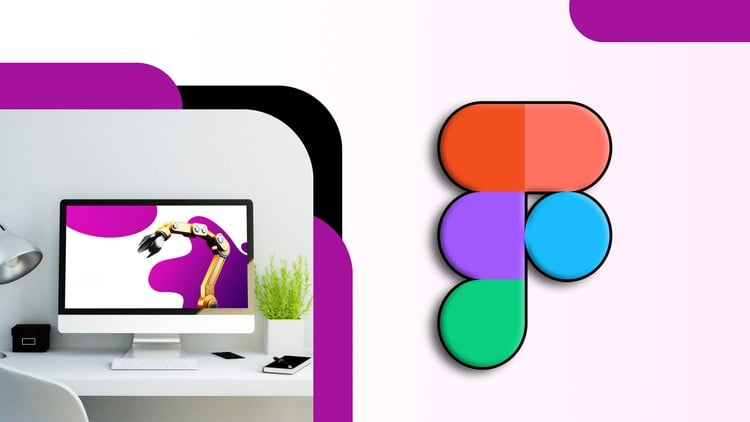
Mastering Your UI/UX Design Skills with Figma’s Essential Features
⏱️ Length: 4.0 total hours
⭐ 4.21/5 rating
👥 45,884 students
🔄 November 2023 update
Add-On Information:
Note➛ Make sure your 𝐔𝐝𝐞𝐦𝐲 cart has only this course you're going to enroll it now, Remove all other courses from the 𝐔𝐝𝐞𝐦𝐲 cart before Enrolling!
- Course Overview
- This intensive 4-hour course, lauded by over 45,000 students, offers a streamlined pathway to mastering Figma, the industry-leading tool for UI/UX design. Meticulously crafted and updated in November 2023, the curriculum reflects the latest best practices and features, ensuring relevant, in-demand skills.
- You’ll navigate Figma’s powerful interface, understanding its capabilities for individual and collaborative design. The course distills complex design theories into actionable steps, focusing on practical application from ideation to handoff.
- It’s a journey where theoretical knowledge meets hands-on application, preparing you for real-world challenges. Beyond software, it cultivates a designer’s mindset, enabling informed decisions for enhanced user satisfaction. The high student rating underscores its effectiveness, making it ideal for aspiring digital product designers.
- Requirements / Prerequisites
- No prior experience with Figma or advanced design software is strictly necessary, making this course accessible to absolute beginners. Basic computer literacy and internet navigation are beneficial.
- A reliable computer (Windows, macOS, or Linux) with a stable internet connection is essential for Figma’s cloud-based nature. While basic design concepts offer a slight advantage, the course introduces all fundamental principles from scratch.
- Enthusiasm for learning and visual problem-solving are key. Active engagement with exercises maximizes skill development. A free Figma account, guided in initial lessons, is required for practical assignments.
- Skills Covered / Tools Used
- Visual Design Execution: Articulate abstract ideas into visually appealing UIs using advanced typography, color theory, spacing, and hierarchy. Master creating clean, functional, and aesthetic layouts for target audiences.
- Interactive Mockup Creation: Bring interfaces to life with sophisticated user flows, micro-interactions, and dynamic transitions. Create realistic prototypes for effective user experience communication, enabling early testing and feedback.
- Systematic Design Thinking: Develop a structured approach by organizing projects efficiently. Understand shared styles, create design systems, and ensure consistency across screens and components for scalable, maintainable designs.
- Collaborative Workflow Optimization: Leverage Figma’s real-time features for seamless teamwork with stakeholders and developers. Master commenting, version history, and feedback streamlining to accelerate design iterations.
- Accessibility-Conscious Design: Integrate inclusive design principles, ensuring products are usable by diverse users. Understand contrast ratios, semantic structure, and alternative input methods to broaden design impact.
- Developer Handoff Preparation: Learn best practices for design-to-code transition. Organize layers, export assets efficiently, and use Figma’s inspection features for clear developer specifications.
- Figma’s Ecosystem Mastery: Deep dive into core functionalities like frames, layers, shapes, pen tool, masks, and effects. Explore essential plugins and integrations to enhance productivity and creative potential.
- Benefits / Outcomes
- Launch Your UI/UX Career: Acquire foundational skills and portfolio pieces to confidently apply for junior UI/UX or product design roles.
- Elevate Existing Design Skills: Refine workflow, learn advanced Figma techniques, and solidify best practices for higher-quality, efficient design.
- Proficiency in Industry-Standard Software: Become highly adept at Figma, boosting marketability in product development.
- Build a Professional Portfolio: Complete real-world projects to showcase abilities, design process, and problem-solving skills to employers/clients.
- Foster a Design Thinking Mindset: Develop a critical eye for user experience, anticipating needs and designing intuitive, problem-solving interfaces.
- Enhanced Collaboration Abilities: Master teamwork in design, contributing effectively to shared projects and communicating decisions clearly.
- Confidence in Design Implementation: Confidently execute complex design tasks, from wireframes to polished, interactive prototypes ready for user testing.
- PROS
- Highly Practical and Project-Oriented: Focuses on hands-on application and real-world scenarios for direct skill transfer.
- Up-to-Date Content: Updated November 2023, ensuring relevance with current Figma features and industry trends.
- Instructor Expertise and Clarity: High student ratings (4.21/5, 45,884 students) indicate effective teaching and clear explanations.
- Beginner-Friendly: Structured for learners with no prior Figma or extensive design experience.
- Efficient Learning Curve: At 4 hours, it delivers essential skills without being overly time-consuming.
- Community Validation: Large student body signifies a well-regarded learning resource.
- CONS
- As an introductory course, it may not delve into highly specialized UI/UX design aspects, requiring further study for expert-level proficiency.
Learning Tracks: English,Design,User Experience Design
Found It Free? Share It Fast!